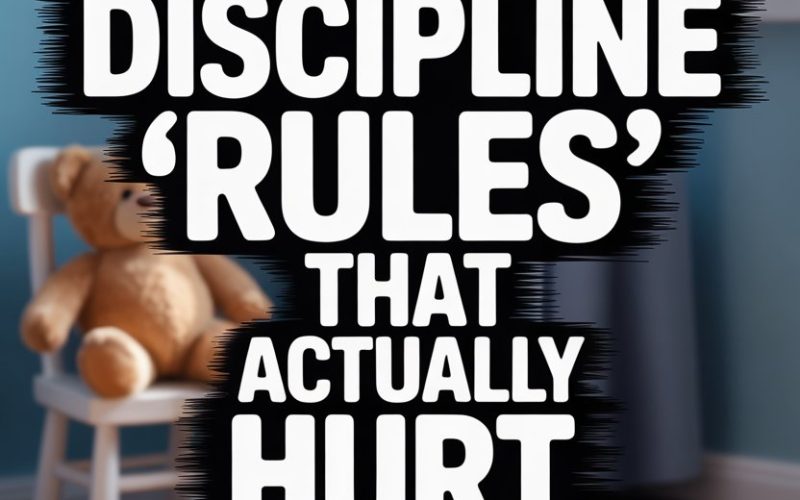Ever hear advice about discipline that makes you pause and wonder if it’s really helpful? You’re not alone.
Busy parents juggle enough already; nobody needs a guilt trip hiding behind outdated “rules” that do more harm than good.
Let’s set the record straight and give you practical, kinder alternatives that work in real households—yes, even yours.
1. Spare the Rod, Spoil the Child
This old chestnut has stubborn longevity, mostly because it sounds biblical (spoiler alert: it’s not, exactly). The idea is that a well-timed smack teaches respect and obedience.
In reality, all it usually teaches is fear—and perhaps how to avoid getting caught next time.
Research, including a comprehensive study by the American Academy of Pediatrics, consistently links physical punishment with higher rates of aggression, anxiety, and long-term mental health issues in children.
Not quite the “respect” anyone’s hoping for.
Kids learn best when they feel safe and loved, not when they’re bracing for impact.
If you’re feeling the urge to lash out, try a pause: count to ten, take a breath, pretend you’re in a BBC drama and need to be exceedingly polite. Anything that gives you—and your child—a moment to reset.
2. Because I Said So
Ah, the classic power move. Utter these four words and watch as your child’s curiosity fades and their resentment grows.
Sure, sometimes you need compliance, stat—nobody’s debating the need for swift shoe-putting-on at 8:02am—but relying on “because I said so” as your main strategy turns you into a walking brick wall.
Children—surprise!—are little humans, hardwired to ask “why?” a thousand times a day.
Experts in child development say that explaining your reasoning builds trust, supports critical thinking, and helps kids internalize rules, not just follow them out of fear.
You don’t need to launch into a TED Talk about the perils of running with scissors, but a quick “we hold hands in the car park so everyone stays safe” goes a long way.
When kids understand the ‘why’, they’re far more likely to cooperate—and you might even hear fewer “whys” next time.
3. Time-Outs for Every Offence
Time-outs are the discipline world’s version of sending someone to the naughty step (or, in British households, the “thinking chair”—so optimistic).
The trouble with constant time-outs is they can quickly become a one-size-fits-all punishment factory, and lose any real meaning.
A 2016 study in the Journal of Developmental & Behavioral Pediatrics found that time-outs can be effective if used sparingly and calmly, but overusing them—or using them angrily—can actually escalate bad behavior.
Constant banishment makes kids feel isolated, not reflective.
Try “time-ins” instead: sit with your child, help them put words to their feelings, and work through the storm together. Sure, it takes longer.
But the goal isn’t just to stop the shouting—it’s to help them learn emotional regulation (and maybe stop them from using your living room curtains as a cape).
4. No Dessert Unless You Clear Your Plate
Somewhere, a grandparent is sighing. But using food as a reward or punishment creates a weird relationship with eating—and teaches kids to ignore their own hunger cues.
A study published in Journal of the Academy of Nutrition and Dietetics found that pressure to eat, especially when tied to dessert, leads to fussier eating and more battles over food in the long run.
Plus, it sets up dessert as the holy grail, and broccoli as the villain.
Instead, offer regular family meals, serve a variety of foods, and let your child’s appetite be the guide. They might surprise you by eating the peas without a bribe. Or not.
Either way, dessert doesn’t need to be a medal for surviving vegetables.
5. Big Boys (or Girls) Don’t Cry
Stiff upper lips may have built empires, but they don’t help kids grow up emotionally healthy.
Shutting down tears with a well-meaning “you’re fine!” or “don’t be such a baby” teaches children that emotions are problems to be hidden, not signals to be understood.
Child psychology experts agree: validating a child’s feelings, even when they seem minor, helps build resilience and emotional intelligence.
That doesn’t mean indulging every whimper, but it does mean giving space for feelings to be felt.
Next time your child’s on the verge of Niagara Falls over a dropped biscuit, try “That really upset you, didn’t it?” You might be amazed at how quickly the storm passes when they know you understand.
And you get the bonus of raising a kid who can actually talk about their feelings, instead of bottling them up until they explode during Year Six SATs.
The Gentle Discipline Toolkit
If you recognize your own parents’ words (or your own, uttered at the end of a long, snack-deprived day), take heart. Nobody gets this right all the time.
Children aren’t little robots who need to be programmed with “consequences” and “boundaries” every moment.
What they need most are connection, understanding, and a good dollop of patience (plus snacks, but you knew that).
Start with small changes: explain your reasoning, swap separations for connection, let emotions (and broccoli) happen.
When you focus on building trust and teaching—not just controlling—discipline becomes less of a power struggle and more of a partnership.
And you might just find your child listens a little better, too. Even if their socks are still mysteriously missing every morning.





